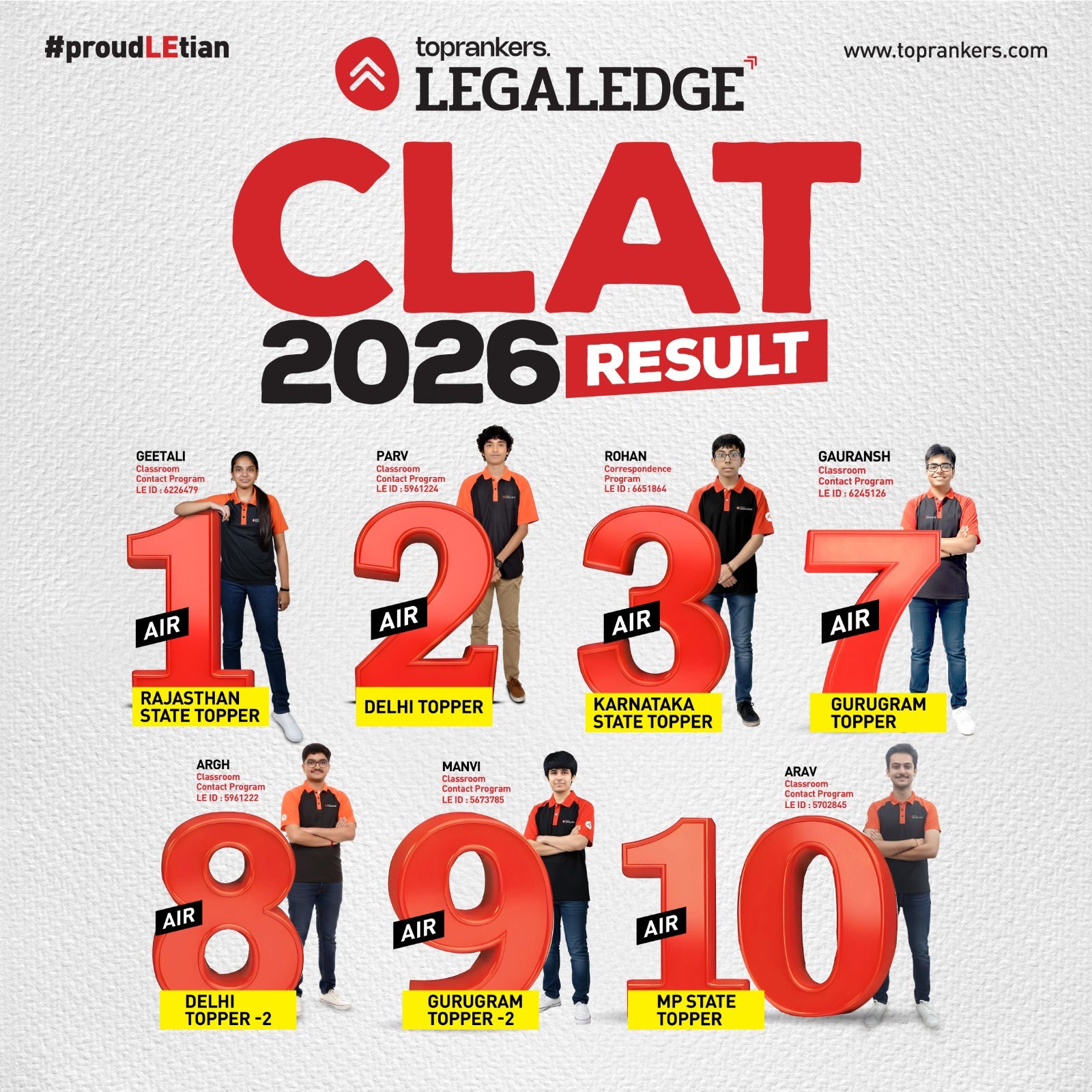How to Fill the CLAT 2026 OMR Sheet? Rules, Avoid Common Errors
November 17, 2025
Reader's Digest: CLAT OMR sheet The CLAT OMR sheet is a necessary component of the CLAT, which is a determinant to give you a fair chance of getting into the top law schools in India. Although you may have prepared for the exam well, wrong filling of the CLAT OMR sheet can cost you valuable marks.
This blog explains the importance of the CLAT OMR sheet, how it should be filled, and how it is evaluated.
Have you ever wondered why even the smartest candidates sometimes miss their dream law colleges? Kabhi kabhi lagta hai, OMR hi bhagwan hai!
If you're prepping for the Common Law Admission Test (CLAT), you'll know it's not just about getting the answers right. It's also about marking them correctly on the CLAT OMR (Optical Mark Recognition) sheet.
Are you sure you are getting all the potential marks due to silly CLAT OMR mistakes? What if there's a strategy that can make all the difference? Dive into our guide and discover the secrets to OMR sheet perfection.

What is OMR?
OMR is short for Optical Mark Recognition, a technology that scans and reads marked data from pre-designed sheets. In competitive exams like CLAT, an OMR sheet is used to record the responses given by candidates. In that sheet, there are different options where bubbles are given, and the candidate marks one of them completely.
The CLAT OMR Sheet is specially designed to ensure the capturing of answers in the right way. As the scanning machines are used for the evaluation, minor mistakes like incomplete shading or multiple markings will lead to incorrect results.
How Does the Blank OMR Sheet for CLAT Looks Like?
Before we get into the details of filling out a sample OMR sheet for CLAT, let's first understand what it looks like:
Rows and Columns: The sheet will have rows, each marked with an alphabet (indicating a question) and columns corresponding to options (usually A, B, C, and D).
| Question No. | A | B | C | D |
|---|---|---|---|---|
| 1 | ||||
| 2 | ||||
| ... |
Read more: CLAT 2026 Application Form
Importance of Correctly Filling CLAT OMR Sheet
As important as knowing the correct answers is filling the CLAT OMR Sheet correctly. Here's why:
- Avoid Marking Errors: If you don't fill the OMR sheet appropriately, your answers might not be read correctly, leading to unnecessary negative marking.
- Ensures accuracy in evaluation Since the CLAT OMR Sheet is scanned by a machine, clarity and accuracy in marking are prerequisites, as any over-shading can be confusing to the scanner.
- Prevents disqualification: Answers that are incorrectly marked, for example, doubly marked answers, invalidate the answers.
- Saves Time: Properly marking the CLAT OMR Sheet in a structured way of marking ensures you do not waste your time correcting mistakes during the exam.
Golden Rules for Filling the OMR Sheet for CLAT
Here are some of the basic rules for filling out the CLAT OMR Sheet:
Explore: Previous Year CLAT Cut-Offs of Different Colleges
- Use a Black or Blue Ball ballpoint pen: Stick to these colour options. Gel pens, fountain pens or pencils are a strict no-no.
- Fill the Circles: When marking your answer, ensure that the entire circle is filled. The OMR machine might not detect partially shaded options.
- Do Not Overlap: If you feel you've marked an answer wrong, don't overwrite or mark another option in the same row. It will be considered void. Instead, carefully erase the initial mark (if allowed) and then darken the correct circle.
- Be Gentle: Pressing too hard might damage the CLAT OMR sheet. On the other hand, being too light might not reflect the mark. So, it's a balance you need to strike.
- Avoid Stray Marks: Be very careful not to make any unnecessary marks on the sheet, as the machine might misinterpret them.
- Fill in the Details Carefully: At the top of the sheet, there are usually sections where you can fill in your name, roll number, and other personal details. Make sure these are filled in accurately, as errors can prevent your sheet from being evaluated.
- Work Fast but Thoughtfully: OMR sheets can be time-consuming, so ensure you're marking them alongside answering questions to avoid a last-minute rush.
Read more: How do you attempt lengthy passages in CLAT?
How to Avoid Common Mistakes While Filling CLAT OMR Sheet PDF?
By being mindful of these common mistakes and following the provided guidance, you can avoid errors while filling out the CLAT OMR sheet:
| Common Pitfalls | How to Avoid Them |
|---|---|
| Neglecting to fill in personal information | Double-check and ensure that all personal details, including name, roll number, and photo, are filled correctly. |
| Misalignment of bubbles or ovals | Carefully mark the bubbles within the designated circles using a black or blue ballpoint pen. |
| Overlapping or spilling ink on the answer sheet | Write neatly and avoid any ink spillage to prevent any confusion or misinterpretation of answers. |
| Marking multiple answers for a single question | Be cautious while marking answers; clearly select only one choice for each question to prevent scoring errors. |
| Incorrect shading or incomplete marks | Fill the bubbles completely, and make sure they are dark enough for the scanning system to detect your response. |
| Skipping or mislabeling question numbers | Check that your responses match the corresponding question number and avoid skipping any questions inadvertently. |
| Failure to verify the OMR sheet before submission | Review your CLAT OMR sheet to confirm that all answers are correctly marked, and ensure that you haven't missed any questions. |
Solve: CLAT Sample Papers
What is the Best CLAT OMR Sheet Filling Strategy?
Now that you know the general tips, let's delve into the strategies of OMR sheet practice for CLAT:
1. Filling After Each Question: This approach involves filling out the CLAT OMR sheet right after answering each question. It ensures you can mark all answers and align with the exam's pace.
2. Filling After Each Section: Filling the CLAT OMR sheet after completing each section or subsection can help you stay immersed in the questions. It also acts as a mental buffer and aids in time management.
3. Filling at the End of the Paper: Some prefer to answer all questions first and then fill out the CLAT OMR sheet. This strategy lets you focus entirely on the content first and manage your time efficiently within each section.
Solve: CLAT Previous Years' Question Papers
How CLAT OMR Sheet is Evaluated
After the exam, the CLAT OMR Sheet undergoes a very accurate scanning and evaluation process.
Step-by-Step Process of CLAT OMR Sheet Evaluation:
- Scanning: The CLAT OMR sheet is fed to an OMR scanner, which scans the responses marked.
- Scanned data is then processed with the help of specialized software. The software identifies correctly and wrongly marked answers.
- Matching with Answer Key: The answers given on the CLAT OMR Sheet are matched with the answer key released by the CLAT authority.
- Calculation of Score: The software applies the marking scheme of CLAT, marking off incorrect answers based on the negative marking policy.
- Result Compilation: The final scores are generated after verification, and the merit list is prepared accordingly.
Conclusion
The CLAT OMR Sheet is going to play the final deciding role in your score. Understanding its significance, as well as proper marking techniques, will avoid unnecessary mistakes. While preparing for CLAT, one should also practice filling out mock CLAT OMR Sheets. Filling a CLAT OMR Sheet correctly ensures that all of your sincere efforts and preparations are properly reflected in your final score.
Key Takeaways
- Use only a black or blue ballpoint pen.
- Ensure the circles are filled without overlapping.
- Avoid stray marks and be gentle with the sheet.
- Fill personal details with utmost accuracy.
- Practice using OMR sheets before the main exam to get comfortable
Read more: Avoid these mistakes while solving CLAT Mock Tests
Frequently Asked Questions
What is an OMR sheet in the CLAT exam?

Which pen should I use to fill the CLAT OMR sheet?

Can I erase or modify my answer on the OMR sheet?

What happens if I mark two answers for one question on the CLAT OMR sheet?

How can I avoid mistakes while filling out the OMR sheet for CLAT?

Should I fill the CLAT OMR sheet after answering each question or at the end of the exam?

Will the candidate get rough sheet in CLAT?

Can I underline the passages in CLAT Question Booklet?

When will we be given OMR, before the question paper to fill the details or it's included in 2 hours?

Do we have to print both pages of the CLAT Admit Card or just one ?







SHARE